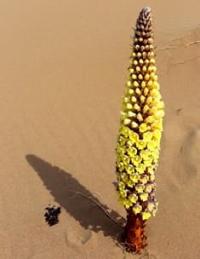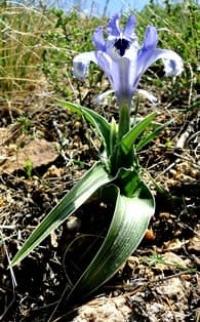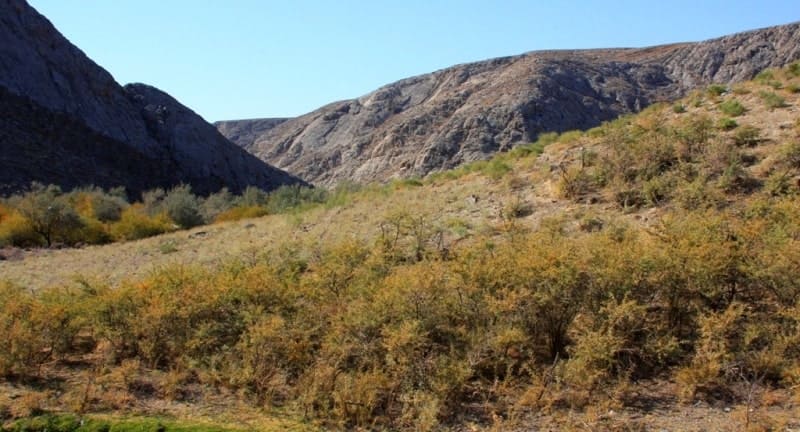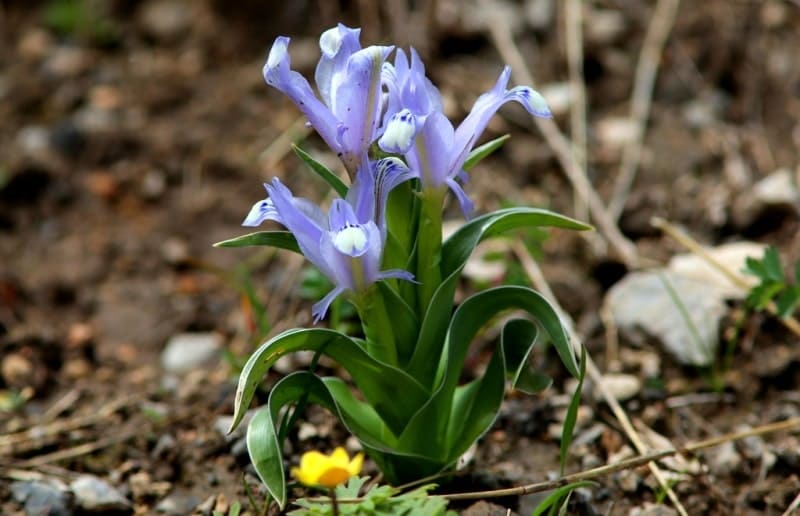Вы здесь
Ridge Small Balkhan.


Sights of Small Balkhan ridge.
“The Balkhans Big and Small are mountains near the eastern shore of the Caspian Sea. The Greater Balkhans have an axis of elevation from north to south and can rather be called an upland (plateau) with steep slopes.
The main rocks are limestones and sandstones. The highest peak is the domed Dirrem-Dag, at 39°42'N. sh. and 72°5'E. D., has an altitude of 1600 meters above sea level. The Shahlu-Burun spur has a length of 12 versts, its peak Lammu-Burun is 800 meters above sea level.
The northern slope of the Big Balkhan has springs in the gorges, where juniper grows up to 7 - 9 meters in height, barberry, cherry and other shrubs. The Small Balkhan is similar in structure and rocks to the large one, its peak is in the western part of the ridge, 795 meters above sea level. Vegetation is less than on the big Big Balkhan.
The upper parts, southern, eastern and western slopes of both ranges are generally poor in it. Between both ridges, the Uzboy valley is the ancient channel of the Amu Darya."
Wed Stebnitsky, "Research on Turkmenia" ("Notes of the Caucasian Department of Geographical Society", vol. VIII). Keshkul, "Geologist. work near the Krasnovodsk Bay” (ibid.).
Encyclopedic Dictionary of Brockhaus and Efron. 86 tons (82 tons and 4 additional). - St. Petersburg, 1890 - 1907.
Trip from Balkanabat to mountains of Small Balkhan.
Small Balkhany mountains are located between the Bolshoy Balkhan ridge and the western spurs of the Kopetdag ridge, in the western tip of the Karakum sands, 54 kilometers southeast of the city of Balkanabat, are located in the Balkan velayat.
Small Balkhan ridge stretches from the southwest to the northeast for 34 kilometers, its maximum width in the northeastern part is 15 kilometers. The highest mark is in the western part, its height is 779.3 meters above sea level.
It is followed by marks with a height of 784 meters above sea level and in the central part of the ridge there is a mark with a height of 753 meters above sea level. On the south side in the vicinity of the Chalsu gorge there are several famous salt springs: Kuidzhik, Gazlysu, Chalsu and Shasharinsu.
Big and Small Balkhans, according to M.V. Muratov, I.A. Rezanov and others, tectonically belong to the Alpine geosynclinal region (area of Cenozoic folding of the Tethys) and, on the basis of geological data, should be united with the Kopetdag.
The Small Balkhan is separated from the Big Balkhan by a synclinal trough, which is occupied by the lower reaches of the dry channel of the Uzboy. This uplift is also an anticline massif. According to its geological features, it should be directly included in the Kopetdag system as its extreme northwestern link.
Small Balkhan reaches an absolute height of 779 meters above sea level, is composed of Cretaceous, partly Paleogene rocks - limestones and marls. Heavily dissected foothills, formed by marls and gypsum-bearing clays, have typically pronounced forms of the so-called clayey karst, which are described in detail in the classic work of the geologist A. D. Natsky (1916).
Apparently, they owe their appearance to karst-suffusion, suffusion processes and underground erosion. The surface of the Small Balkhan is occupied mainly by wormwood and wormwood-saltwort desert. southern type.
This flat-topped low-mountain massif is used by the local Turkmen population as a pasture. The foothills are strongly dissected; they are composed of marls and gypsum-bearing clays. The foothills have pronounced forms of the so-called clayey karst, which arose due to karst-suffusion, suffusion processes and underground erosion.
This miniature mountain system is composed of rocks of different age - limestones, sandstones, marls. These are variegated Paleogene and Akchagyl rocks, as well as Neogene conglomerates. A third of the Small Balkhan is covered with weathering products of rocks with fine earth, this is a kind of soil.
The rest of the slope area is occupied by rocky outcrops. The local climate for the mountains is extremely dry. The harsh climate predetermined the desert appearance of the Small Balkhan, it is especially pronounced in the summer-autumn period.
Mountain steppes occupy the peaks of the ridge at an altitude of 600 - 770 meters, where the vegetation cover is better developed. However, its species composition here is poorer. Among herbs, sedge, grasses predominate, there are Kopetdag eremurus, tulips, irises, and ixiolirion.
307 plant species were found on the Small Balkhan. Among them, there are only six different trees - juniper (Juniper Turkmen) at the lower limit of its Aral. And also goof east, tugai poplar, three types of tamariks. All these tree species grow in single specimens or in small groups.
The sucker trees, tamarisk trees grow at the outlets to groundwater and along the channels of temporary watercourses, reed, kendyr, horsetail and other moisture-loving herbs are also found here.
Geographical coordinates of Small Balkhan ridge: N39°18'16.07" E54°55'40.04"






Authority:
N. A. Gvozdetsky, N. I. Mikhailov. “Physical geography of the USSR. Asian part. Third edition, revised and enlarged. Moscow "Thought" 1978. http://tapemark.narod.ru/geograf/1_5_5.html
https://alpagama.org/malyj-balhan.html
Photos by
Alexander Petrov.







